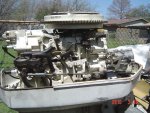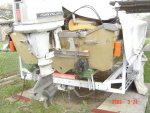I bought an old Sea King boat and motor last year and am trying to get it living again. The boat is a time capsule...it looks nearly new. Everything is solid and in great condition. It was clearly loved and stored indoors all its life.
The motor looks really clean. When I bought it, the gentleman I bought it from just said "the motor needs some work." I was so pleased with the boat that I really didn't even care if it ran or not.
I did a compression test on it when I got it home last fall, and I had 140 in both cylinders. I hooked it up to muffs and I could get it running without much effort, but it ran rough. I stored it away until this spring, and here's what I have so far.
When I first started it this spring, while it was running rough, I pulled the top plug wire and nothing happened. Kept running the same. Reinstalled that wire and pulled the bottom one and it died instantly. I removed the wires, inspected them, and switched their positions. This time it ran better and when I would pull either one it would run rougher but keep running.
Being impatient, I took it to the lake to see how it would run under throttle. Idled rough, vibrations at slow no wake speed, but wide open it was pretty good. However, while running WOT it bogged down and quit. I had to let it sit for 5 minutes, then it fired up and ran for another 10 minutes. We had to idle before a bridge, and it died. Couldn't get it restarted.
So I installed new plugs and wires. I filed and reset the points. I installed a new impeller. I changed the lower unit oil.
As I have never timed an outboard, I was able to find a guy about a hour from my house who said he is an expert on these motors. His fee for a tune up was very reasonable, so I took the boat out there on a Saturday and he dug in. Right away we realized I was not pumping water. I figured I screwed up the impeller somehow, so I removed the lower unit and found the water tube was not seated in the gasket off of the pump. Fixed that and we were pumping again.
We installed a new diaphragm in the fuel pump. Adjusted the idle needle valve and idle speed. When it came time to adjust the timing I think I have over stayed my welcome as I had been there 2 hours and planned just 1. He hooked up an automotive timing light, made a mark on the flywheel as we couldn't find one, looked at it quickly and said it looked good. I had no idea what he was looking at.
We took it up to the lake for the 4th of July, and it was hard to start. Once I got it running, it ran well for about 10 laps. While running at WOT, the overheat light came on. We shut it down right away, let it sit for about 15 minutes, and then started back up. No light, and we were pumping water. Another lap, and then a repeat of the first time out on the lake...just bogged down and died. I could not restart it.
Back home, I was able to get it to start on starting fluid, and then could keep it running by revving it a bit. But I now had backfiring. A compression test revealed 140 on the bottom, 70 on top. Pulled the head and found a blown head gasket.
I got a sheet of heavy glass and adhered 120 grit sandpaper to it. Moving the head in a figure 8, I slowly progressed to get the surface shined up. If the presentation of low spots was any indication, the head does seem to have been warped. After a lot of elbow grease, all areas are nice and clean. I carefully scraped and sanded the block as well. Just out of curiosity (I won've received the gasket until Monday) I mated the head to the block to see how it fit. Interestingly, it seems high in the middle, as it teeters a bit. I can rock the head up and down pivoting in the middle. When I hold the bottom of the head tight to the block, I can get a .006 feeler gauge in between the head and block at the top edge.
Is that ok? Am I concerned over nothing as I don't have the gasket in there?
Thoughts?
Also, I thought maybe now would be a great time to time the ignition, as I can clearly see when I am at TDC. However, according to the manual, I need a special tool (rod) with marks as I am trying to find 32 degrees before TDC, and I don't have this tool. The manual uses a test light to adjust the opening and closing of the points based on the tool mentioned. The guy that helped me tune this up before the 4th of July holiday weekend didn't convince me that it was really timed right. Maybe that had something to do with the failure I am experiencing?
Advice is so much appreciated.

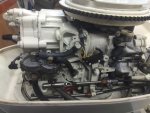

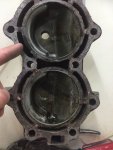
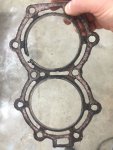
The motor looks really clean. When I bought it, the gentleman I bought it from just said "the motor needs some work." I was so pleased with the boat that I really didn't even care if it ran or not.
I did a compression test on it when I got it home last fall, and I had 140 in both cylinders. I hooked it up to muffs and I could get it running without much effort, but it ran rough. I stored it away until this spring, and here's what I have so far.
When I first started it this spring, while it was running rough, I pulled the top plug wire and nothing happened. Kept running the same. Reinstalled that wire and pulled the bottom one and it died instantly. I removed the wires, inspected them, and switched their positions. This time it ran better and when I would pull either one it would run rougher but keep running.
Being impatient, I took it to the lake to see how it would run under throttle. Idled rough, vibrations at slow no wake speed, but wide open it was pretty good. However, while running WOT it bogged down and quit. I had to let it sit for 5 minutes, then it fired up and ran for another 10 minutes. We had to idle before a bridge, and it died. Couldn't get it restarted.
So I installed new plugs and wires. I filed and reset the points. I installed a new impeller. I changed the lower unit oil.
As I have never timed an outboard, I was able to find a guy about a hour from my house who said he is an expert on these motors. His fee for a tune up was very reasonable, so I took the boat out there on a Saturday and he dug in. Right away we realized I was not pumping water. I figured I screwed up the impeller somehow, so I removed the lower unit and found the water tube was not seated in the gasket off of the pump. Fixed that and we were pumping again.
We installed a new diaphragm in the fuel pump. Adjusted the idle needle valve and idle speed. When it came time to adjust the timing I think I have over stayed my welcome as I had been there 2 hours and planned just 1. He hooked up an automotive timing light, made a mark on the flywheel as we couldn't find one, looked at it quickly and said it looked good. I had no idea what he was looking at.
We took it up to the lake for the 4th of July, and it was hard to start. Once I got it running, it ran well for about 10 laps. While running at WOT, the overheat light came on. We shut it down right away, let it sit for about 15 minutes, and then started back up. No light, and we were pumping water. Another lap, and then a repeat of the first time out on the lake...just bogged down and died. I could not restart it.
Back home, I was able to get it to start on starting fluid, and then could keep it running by revving it a bit. But I now had backfiring. A compression test revealed 140 on the bottom, 70 on top. Pulled the head and found a blown head gasket.
I got a sheet of heavy glass and adhered 120 grit sandpaper to it. Moving the head in a figure 8, I slowly progressed to get the surface shined up. If the presentation of low spots was any indication, the head does seem to have been warped. After a lot of elbow grease, all areas are nice and clean. I carefully scraped and sanded the block as well. Just out of curiosity (I won've received the gasket until Monday) I mated the head to the block to see how it fit. Interestingly, it seems high in the middle, as it teeters a bit. I can rock the head up and down pivoting in the middle. When I hold the bottom of the head tight to the block, I can get a .006 feeler gauge in between the head and block at the top edge.
Is that ok? Am I concerned over nothing as I don't have the gasket in there?
Thoughts?
Also, I thought maybe now would be a great time to time the ignition, as I can clearly see when I am at TDC. However, according to the manual, I need a special tool (rod) with marks as I am trying to find 32 degrees before TDC, and I don't have this tool. The manual uses a test light to adjust the opening and closing of the points based on the tool mentioned. The guy that helped me tune this up before the 4th of July holiday weekend didn't convince me that it was really timed right. Maybe that had something to do with the failure I am experiencing?
Advice is so much appreciated.





Last edited:




















